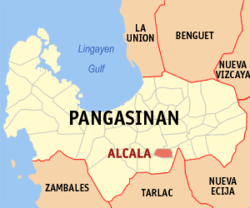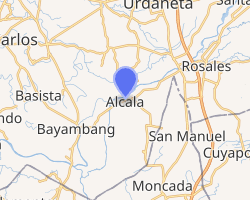Alcala, Pangasinan
Alcala, officially the Municipality of Alcala (Pangasinan: Baley na Alcala; Ilocano: Ili ti Alcala; Tagalog: Bayan ng Alcala), is a 3rd class municipality in the province of Pangasinan, Philippines. According to the 2015 census, it has a population of 43,402 people.[3]
Alcala | |
|---|---|
| Municipality of Alcala | |
 Seal | |
| Motto(s): Kalinisan, Kalusugan, Karapatan (English: Environment, Health, Rights) | |
 Map of Pangasinan with Alcala highlighted | |
OpenStreetMap 
| |
.svg.png) Alcala Location within the Philippines | |
| Coordinates: 15°50′48″N 120°31′19″E | |
| Country | |
| Region | Ilocos Region (Region I) |
| Province | Pangasinan |
| District | 5th district |
| Founded | September 20, 1875 |
| Barangays | 21 (see Barangays) |
| Government | |
| • Type | Sangguniang Bayan |
| • Mayor | Jojo B. Callejo |
| • Vice Mayor | Rodolfo C. Rosquita |
| • Congressman | Ramon V. Guico III |
| • Electorate | 29,134 voters (2019) |
| Area | |
| • Total | 45.71 km2 (17.65 sq mi) |
| Population (2015 census)[3] | |
| • Total | 43,402 |
| • Density | 950/km2 (2,500/sq mi) |
| • Households | 10,057 |
| Economy | |
| • Income class | 3rd municipal income class |
| • Poverty incidence | 12.35% (2015)[4] |
| • Revenue (₱) | 148,190,126.55 (2016) |
| Time zone | UTC+8 (PST) |
| ZIP code | 2425 |
| PSGC | |
| IDD : area code | +63 (0)75 |
| Climate type | tropical monsoon climate |
| Native languages | Pangasinan Ilocano Tagalog |
| Major religions | Roman Catholic |
| Feast date | May 3(Feast of the Finding of the True Cross) |
| Catholic diocese | Roman Catholic Diocese of Urdaneta |
| Patron saint | Santa Cruz de Alcala |
It has a land area of 5,508 hectares.
Alcala recently broke the world record for longest grill measuring about 3 kilometres (9,840 ft).
History
What is known now as Alcala was formerly a barrio of Bayambang, formerly called "Dangla", a vernacular term referring to a medicinal shrub which grows abundantly in the place. As a barrio, it was subdivided into several smaller units called sitios, namely: Bugyao, Bacud, Cupi, Bitulao, Cabicalan, Patalan, Camanggaan and Sinabaan
On April 1, 1873, the settlers established a community. They submitted a petition calling for the cessation of Dangla into a separate township, but it took more than two years for the Spanish Authorities to take notice of the settlers' demands.
Finally, on September 20, 1875, a Royal Decree No. 682 was issued making the place an official municipality to be named Alcala, the name of a town in Spain where the then Governor of Pangasinan hailed from.
During the outbreak of the Philippine-American War, the place was the site of the field headquarters of General Malone of the United States Army.
When the Filipinos and Americans were fighting against the Japanese during World War II, the place was the site for the American Field Headquarters under the command of General Johnathan Wainwright. It is here that the first Guerrilla Combat Training School was established. The same school produced an Infantry Battalion composed mostly of Alcaleneans who played an important role in defending the whole of Northern Luzon from the superior Japanese Forces.[5][6]
Barangays
Alcala is politically subdivided into 21 barangays.[7]
- Anulid
- Atainan
- Bersamin
- Canarvacanan
- Caranglaan
- Curareng
- Gualsic
- Kisikis
- Laoac
- Macayo
- Pindangan Centro
- Pindangan East
- Pindangan West
- Poblacion East
- Poblacion West
- San Juan
- San Nicolas
- San Pedro Apartado
- San Pedro Ili
- San Vicente
- Vacante
Demographics
| Year | Pop. | ±% p.a. |
|---|---|---|
| 1903 | 9,008 | — |
| 1918 | 9,054 | +0.03% |
| 1939 | 12,697 | +1.62% |
| 1948 | 17,064 | +3.34% |
| 1960 | 20,297 | +1.46% |
| 1970 | 22,208 | +0.90% |
| 1975 | 24,376 | +1.89% |
| 1980 | 24,993 | +0.50% |
| 1990 | 30,684 | +2.07% |
| 1995 | 31,974 | +0.77% |
| 2000 | 35,734 | +2.41% |
| 2007 | 38,934 | +1.19% |
| 2010 | 41,077 | +1.97% |
| 2015 | 43,402 | +1.05% |
| Source: Philippine Statistics Authority[3][8][9][10] | ||
Local government
The elected officials for the 2016–2019 term are:[11]
- Mayor: Jojo B. Callejo
- Vice Mayor: Rodolfo C. Rosquita
- Municipal Councilors (Sangguniang Bayan Members):
- Councilor Gerardo G. Ablao
- Councilor Eduardo B. dela Cruz, Jr.
- Councilor Reynaldo A. Catalan
- Councilor Emme Luisa E. Ramos
- Councilor Amor G. Espiritu
- Councilor Camilo P. Cerezo
- Councilor Top Jigur M. Peregrino
- Councilor Johnny E. Carajay
- Councilor Darius Bauzon (Liga ng mga Barangay President - Alcala Chapter)
- SKF President Jershey Angelique Bajo
Climate
| Climate data for Alcala, Pangasinan | |||||||||||||
|---|---|---|---|---|---|---|---|---|---|---|---|---|---|
| Month | Jan | Feb | Mar | Apr | May | Jun | Jul | Aug | Sep | Oct | Nov | Dec | Year |
| Average high °C (°F) | 31 (88) |
31 (88) |
31 (88) |
33 (91) |
32 (90) |
32 (90) |
30 (86) |
30 (86) |
30 (86) |
31 (88) |
31 (88) |
31 (88) |
31 (88) |
| Average low °C (°F) | 21 (70) |
21 (70) |
22 (72) |
24 (75) |
24 (75) |
24 (75) |
23 (73) |
23 (73) |
23 (73) |
23 (73) |
23 (73) |
22 (72) |
23 (73) |
| Average precipitation mm (inches) | 5.1 (0.20) |
11.6 (0.46) |
21.1 (0.83) |
27.7 (1.09) |
232.9 (9.17) |
350.8 (13.81) |
679.8 (26.76) |
733.1 (28.86) |
505 (19.9) |
176.6 (6.95) |
67.2 (2.65) |
17.7 (0.70) |
2,828.6 (111.38) |
| Average rainy days | 3 | 3 | 3 | 4 | 14 | 18 | 23 | 25 | 22 | 15 | 8 | 4 | 142 |
| Source: World Weather Online[12] | |||||||||||||
Tourism
A tilapia dispersal and barbecue are part of the attractions in Alcala.[13]
The 2012 Red Bikini Open was held in San Juan.[14]
Alcala celebrated the founding anniversary and annual Tukar Festival (Music Festival) every September 20
Alcala celebrated their fiesta on May 1–3
San Vicente, Alcala has its Backpack Project.
Holy Cross Parish Church
The 1881 Holy Cross Parish Church is a Vicariate of Sacred Heart. Its Feast Day are May 3 is the Feast of the Finding of the True Cross and September 14 is the Feast of the Exaltation of the Holy Cross, with the present Parish Priest, Rev. Fr. Hurley John S. Solfelix) under the jurisdiction of the Roman Catholic Diocese of Urdaneta.
The January 4, 1881 Spanish Royal Decree of the Spanish Government created the Parish of the Holy Cross and accepted by the Dominicans (House of the Order) on November of 188. Padre Eduardo Saamaniego, O.P., was appointed first parish priest on February 21, 1882. The convent was erected under Fr. Revilla and Fr. Casamitjana but the same was destroyed.[15]
In 1950, Padre Jose V. Ferrer caused the destruction of the old church and instead built a semi-concrete edifice. Aided by Bishop Jesus Sison and Archbishop Mariano Madriaga, the Priest founded the Holy Rood Academy. Fr. Amado Lopez continued the rehabilitation of the Church and school but the 1967 and 1968 Casiguran earthquake annihilated the Church. Thus, Fr. Eusebio Vigilia and Fr. Johnny Tagalicud (1972-1977) rehabilitated the present new Church. (Source, 2007 Fiesta Yearbook of Bani, Pangasinan Church).
- Facade of the Holy Cross Parish (F-1881) Parish Church
- Bell tower
- Main altar
- Interior
Schools
Elementary schools:
- Alcala Central School
- South Central School
- Anulid Elem. School
- Atainan Elem. School
- Bersamin Elem. School
- Gualsic Elem. School
- Guinawedan Elem. School
- Laoac Elem. School
- Macayo Integrated School
- Pindangan West Elem. School
- Pindangan East Elem. School
- San Juan Elem. School
- San Pedro Apartado Elem. School
- San Pedro Ili Elem. School
- San Vicente Elem. School
- Vacante Elem. School
Secondary schools:
- Cipriano P. Primicias National High School
- Arboleda National High School
- Pindangan National High School
- Canarvacanan National High School
- San Pedro Apartado National High School
- Bersamin Agro-Industrial High School
- Macayo Integrated School
Private schools:
- Holy Rood Academy
- Our Lady of Peace Academy
- Alcala Brookside School Inc.
- Holy Family Educational Institution
- Alcala Christian Academy
- God's Favor Learning Center Inc.
Gallery
- Municipal Hall
- Teachers street
- Alcala public market
- The Agno River
- Welcome arch
References
- "Municipality". Quezon City, Philippines: Department of the Interior and Local Government. Retrieved 31 May 2013.
- "Province: Pangasinan". PSGC Interactive. Quezon City, Philippines: Philippine Statistics Authority. Retrieved 12 November 2016.
- Census of Population (2015). "Region I (Ilocos Region)". Total Population by Province, City, Municipality and Barangay. PSA. Retrieved 20 June 2016.
- "PSA releases the 2015 Municipal and City Level Poverty Estimates". Quezon City, Philippines. Retrieved 1 January 2020.
- "Archived copy". Archived from the original on 2012-03-28. Retrieved 2012-12-17.CS1 maint: archived copy as title (link)
- "Archived copy". Archived from the original on 2013-12-10. Retrieved 2012-12-17.CS1 maint: archived copy as title (link)
- "Province: PANGASINAN". PSGC Interactive. Makati City, Philippines: National Statistical Coordination Board. Archived from the original on 14 November 2012. Retrieved 26 November 2012.
- Census of Population and Housing (2010). "Region I (Ilocos Region)". Total Population by Province, City, Municipality and Barangay. NSO. Retrieved 29 June 2016.
- Censuses of Population (1903–2007). "Region I (Ilocos Region)". Table 1. Population Enumerated in Various Censuses by Province/Highly Urbanized City: 1903 to 2007. NSO.
- "Province of Pangasinan". Municipality Population Data. Local Water Utilities Administration Research Division. Retrieved 17 December 2016.
- "Official City/Municipal 2013 Election Results". Intramuros, Manila, Philippines: Commission on Elections (COMELEC). 1 July 2013. Retrieved 3 September 2013.
- "Alcala, Pangasinan: Average Temperatures and Rainfall". World Weather Online. Retrieved 23 September 2015.
- http://www.pangasinan.gov.ph/photo-gallery/news-and-events/2011-2/august-2011/tilapia-dispersal-in-alcala-pangasinan/
- https://www.youtube.com/watch?v=IV3BnJMjt1k
- http://capitalpangasinan.blogspot.com/2008/02/all-churches.html
External links
| Wikimedia Commons has media related to Alcala, Pangasinan. |